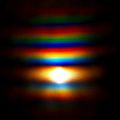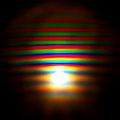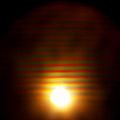Squeeze rings


Quételet rings are colored, more or less arcuate phenomena in the scattering of light at contaminated, specular arise surfaces. They are named after the astronomer Adolphe Quetelet , who observed and explained their formation, but are also known as Whewell's rings after the scientist William Whewell . Occasionally, the term Newtonian dust rings is also found , as Isaac Newton discovered these phenomena at the end of the 17th century without being able to interpret or explain them.
Squeeze rings arise from the simultaneous reflection and scattering of coherent light, when the interfering rays travel different distances depending on the viewing angle within the coherence length of the light, acquire an angle-dependent phase position and thus intensify or extinguish each other. With white light sources, the light is also split into its spectral components because of the wavelength-dependent diffraction . The closer the light source is to the observer, the greater the distance between the virtual rings and the more clearly they emerge. The lines that only appear to lie on the reflecting surface shift with the moving observer.
Such rings can also be observed in nature as corons in the atmosphere under certain conditions .
Photographs

Eccentric photographs of a camera focused to infinity of squeezed rings on a talc- dusted mirror (50 centimeters in diameter) set up five meters away at various lateral distances of a small incandescent lamp (visible in the images as a bright white spot):
Squeeze rings can, for example, also be observed in sunlight on slightly contaminated water surfaces.
Individual evidence
- ↑ Karl Exner : About the Newtonian dust rings
- ↑ Joachim Schlichting: Color wreaths on dusty waters (PDF; 581 kB), Physics in our time, Wiley-VCH Verlag, 35th year (2004), number 2, pages 86 to 89
Web links
- Two-beam interference: thin layers, birefringence and polarization , Institute for Theoretical Physics, University of Hanover
- Joachim Schlichting: Quetelet rings on windows (PDF; 488 kB), Physics in Our Time, Wiley-VCH Verlag, Volume 36 (2004), Number 4, Pages 185 to 187



